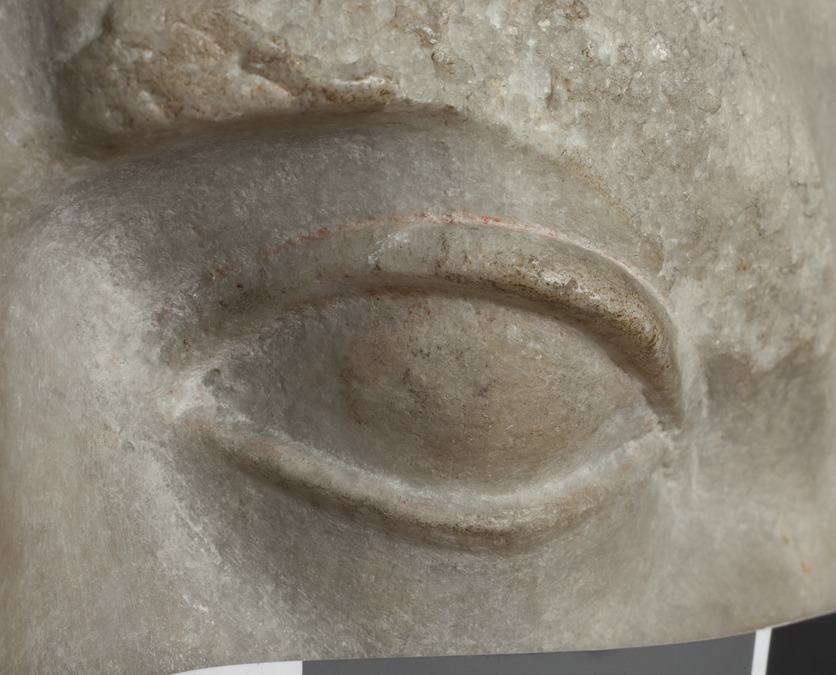Portrait of a Client ruler or Priest-king
Summary
This portrait exhibits small traces of red in the face, in the hair, between the lips, along the eyelid, eye-rim and eyelashes. The red has not yet been identified although this was attempted by non-invasive XRF analysis. Traces of metal are found in one of the drilled holes on the head’s diadem. The SEM/EDX analysis shows a brass content and a few particles of silver. A high concentration of gold found in the silver suggests that the metal is most likely original.
Description of object
Portrait of an older man, probably a Client ruler or a Priest-king shaped in such a way that it could be mounted upon a statue. Vestiges of drapery are preserved on the surface of the back of the neck. The man wears a circular hairband or diadem. Three holes drilled into the crown of the head immediately above the line of the diadem, for the purpose of fastening something like a garland. The face is well preserved, only the eyebrows are missing. The right side of the back of the head and neck has been broken off and is missing as well. The surface has flakes which in some areas have fallen off, as seen on the forehead. Weathering can be observed on the left ear and in the hair. The marble surface appears to have been cleaned.
Choice of methods
Visual examination
- Macroscopic
- Microscopic in situ
Technical imaging
- UV
- VIL
Sampling
- SEM/EDX
- XRF
Visual examination
Red is found on the skin in several locations, in the iris of the left eye, along the eye-rim and eyelid of both eyes, between the eyebrows, indicating eyelashes, in the hair, on the upper lip and between the lips. Traces of metal are found in the first hole to the left.
Technical imaging
UV-FL: A small area in the right eye exhibits a strong yellowish fluorescence probably due to some modern material. The left iris becomes clearer but fluorescent phenomena are not observed.
VIL: Luminescent phenomena indicating Egyptian Blue are not observed.
Other types of investigation
XRF: An attempt was made to identify the red in the hair and on the left eye-rim with a hand-held XRF without any result. This is probably due to the paucity of traces.
SEM/EDX: A sample of the metal was taken for further investigation. The result of the SEM/EDX analysis shows a brass content with a small amount of zinc (6-7 %) and arsenic. The metal is badly corroded, which makes it difficult to determine the precise alloy. Besides the brass content, small particles of silver alloyed with copper and gold are found in the sample. The silver seems to be more corroded than the brass. Other particles found: tin, bronze, sulphur and calcium. Because of the corrosion it is difficult to tell whether the metal is original or secondary. The high content of gold found in the silver suggests that the metal dates from before the 1st cent CE or between 400-900 CE but not later. The arsenic content in the brass suggests that it is old, but it can also be a modern zinc brass alloy (gilding metal). Brass came into use in the Roman period between the 1st cent CE and 400 CE. The silver and the brass exist independently and may not have been applied simultaneously.
Bibliography
F. Poulsen (1951), Catalogue of Ancient Sculpture in the Ny Carlsberg Glyptotek, Copenhagen, cat. no. 455.
F. Johansen (1994), Catalogue. Roman Portraits I. Ny Carlsberg Glyptotek, Copenhagen, cat. no. 13.
- IN 1583
- Portrait
- 1st cent. B.C.E.
- Roman Republican
- White marble
- Purchased in 1897 from the Hard Castle in the canton of Thurgau, Switzerland.
- H. with plinth: 43 cm.; H. without plinth: 33 cm.; W. 23.5 cm.; D. 27 cm.








